Construction Site Management Report: Building Codes and Construction
VerifiedAdded on 2020/02/24
|6
|937
|68
Report
AI Summary
This report provides an analysis of construction site management, focusing on a residential building with shops on the ground floor. Task 1 examines fire resistance according to the Building Code of Australia, classifying the building and detailing fire resistance levels (FRL) for various elements like external walls, internal walls, floors, and roofs. The report differentiates between Class 2 and Class 5 storeys and their respective FRL requirements. Task 2 outlines the concreting process, including pre-concreting checks such as formwork preparation (cleaning, leak testing, and alignment), material inspection, and safety measures. The report emphasizes worker training and protective clothing. It assumes that slabs and beams are cast together, with only electrical and plumbing services installed during the slab installation. References include the National Construction Code, and other relevant resources.
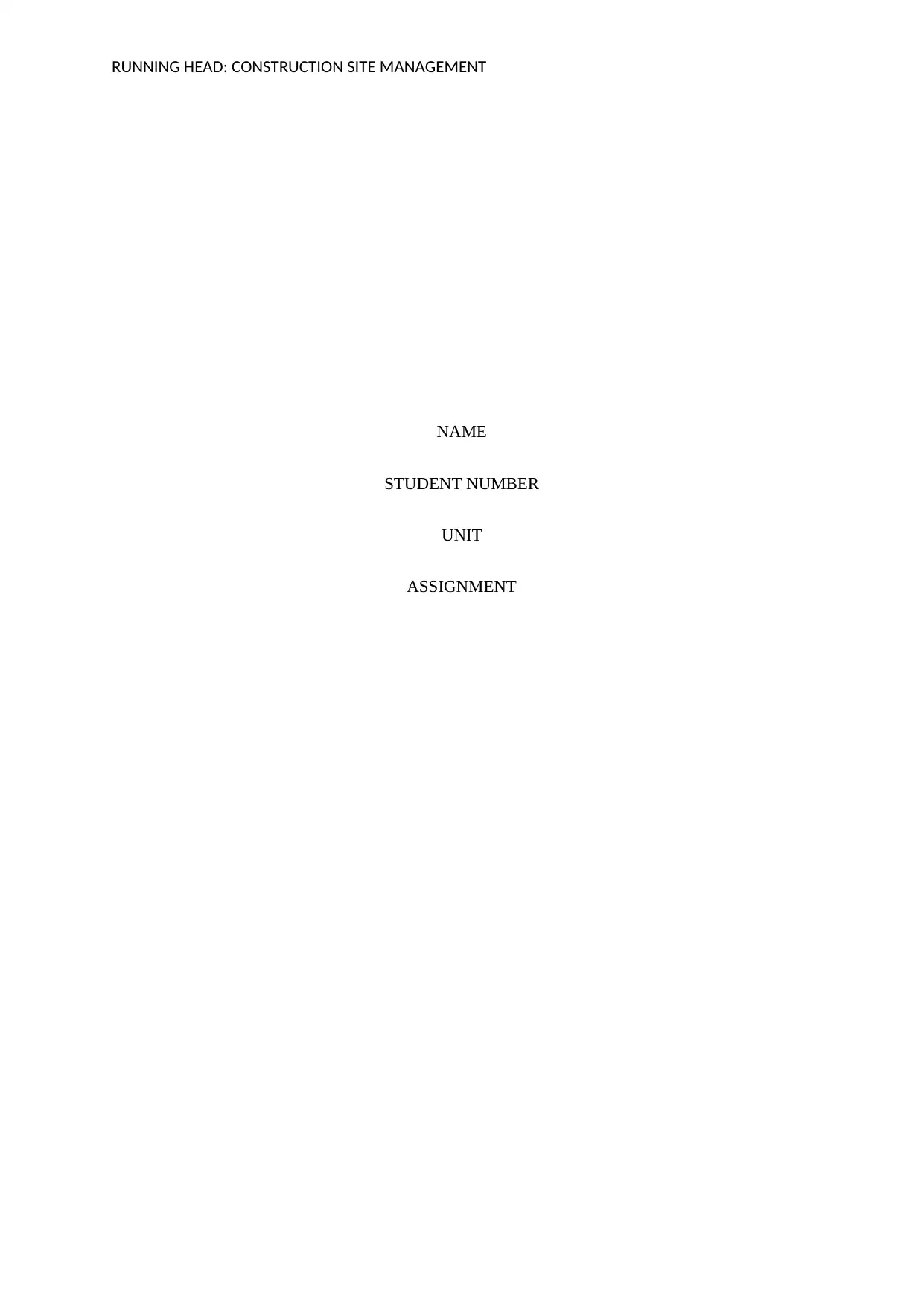
RUNNING HEAD: CONSTRUCTION SITE MANAGEMENT
NAME
STUDENT NUMBER
UNIT
ASSIGNMENT
NAME
STUDENT NUMBER
UNIT
ASSIGNMENT
Paraphrase This Document
Need a fresh take? Get an instant paraphrase of this document with our AI Paraphraser
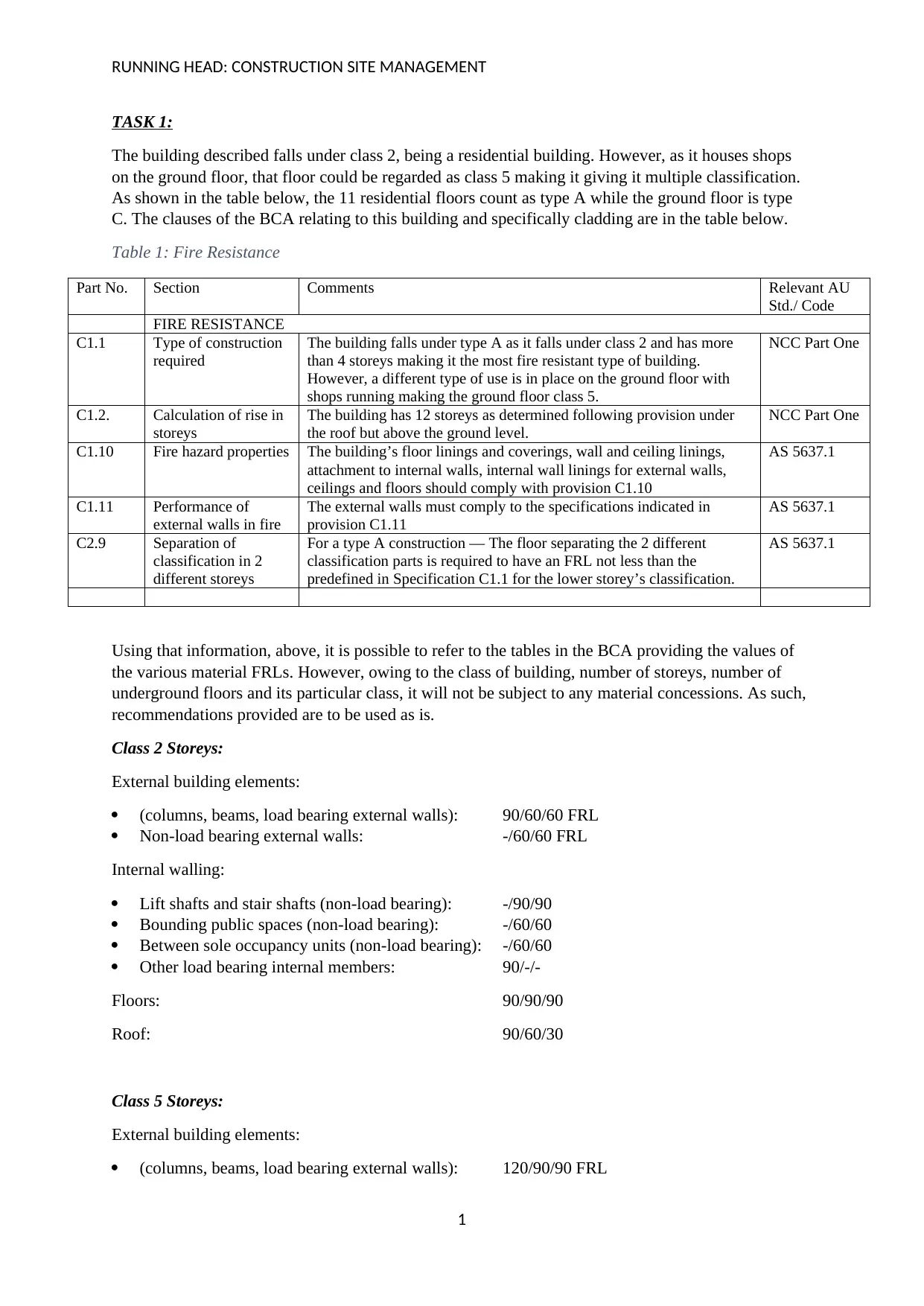
RUNNING HEAD: CONSTRUCTION SITE MANAGEMENT
TASK 1:
The building described falls under class 2, being a residential building. However, as it houses shops
on the ground floor, that floor could be regarded as class 5 making it giving it multiple classification.
As shown in the table below, the 11 residential floors count as type A while the ground floor is type
C. The clauses of the BCA relating to this building and specifically cladding are in the table below.
Table 1: Fire Resistance
Part No. Section Comments Relevant AU
Std./ Code
FIRE RESISTANCE
C1.1 Type of construction
required
The building falls under type A as it falls under class 2 and has more
than 4 storeys making it the most fire resistant type of building.
However, a different type of use is in place on the ground floor with
shops running making the ground floor class 5.
NCC Part One
C1.2. Calculation of rise in
storeys
The building has 12 storeys as determined following provision under
the roof but above the ground level.
NCC Part One
C1.10 Fire hazard properties The building’s floor linings and coverings, wall and ceiling linings,
attachment to internal walls, internal wall linings for external walls,
ceilings and floors should comply with provision C1.10
AS 5637.1
C1.11 Performance of
external walls in fire
The external walls must comply to the specifications indicated in
provision C1.11
AS 5637.1
C2.9 Separation of
classification in 2
different storeys
For a type A construction — The floor separating the 2 different
classification parts is required to have an FRL not less than the
predefined in Specification C1.1 for the lower storey’s classification.
AS 5637.1
Using that information, above, it is possible to refer to the tables in the BCA providing the values of
the various material FRLs. However, owing to the class of building, number of storeys, number of
underground floors and its particular class, it will not be subject to any material concessions. As such,
recommendations provided are to be used as is.
Class 2 Storeys:
External building elements:
(columns, beams, load bearing external walls): 90/60/60 FRL
Non-load bearing external walls: -/60/60 FRL
Internal walling:
Lift shafts and stair shafts (non-load bearing): -/90/90
Bounding public spaces (non-load bearing): -/60/60
Between sole occupancy units (non-load bearing): -/60/60
Other load bearing internal members: 90/-/-
Floors: 90/90/90
Roof: 90/60/30
Class 5 Storeys:
External building elements:
(columns, beams, load bearing external walls): 120/90/90 FRL
1
TASK 1:
The building described falls under class 2, being a residential building. However, as it houses shops
on the ground floor, that floor could be regarded as class 5 making it giving it multiple classification.
As shown in the table below, the 11 residential floors count as type A while the ground floor is type
C. The clauses of the BCA relating to this building and specifically cladding are in the table below.
Table 1: Fire Resistance
Part No. Section Comments Relevant AU
Std./ Code
FIRE RESISTANCE
C1.1 Type of construction
required
The building falls under type A as it falls under class 2 and has more
than 4 storeys making it the most fire resistant type of building.
However, a different type of use is in place on the ground floor with
shops running making the ground floor class 5.
NCC Part One
C1.2. Calculation of rise in
storeys
The building has 12 storeys as determined following provision under
the roof but above the ground level.
NCC Part One
C1.10 Fire hazard properties The building’s floor linings and coverings, wall and ceiling linings,
attachment to internal walls, internal wall linings for external walls,
ceilings and floors should comply with provision C1.10
AS 5637.1
C1.11 Performance of
external walls in fire
The external walls must comply to the specifications indicated in
provision C1.11
AS 5637.1
C2.9 Separation of
classification in 2
different storeys
For a type A construction — The floor separating the 2 different
classification parts is required to have an FRL not less than the
predefined in Specification C1.1 for the lower storey’s classification.
AS 5637.1
Using that information, above, it is possible to refer to the tables in the BCA providing the values of
the various material FRLs. However, owing to the class of building, number of storeys, number of
underground floors and its particular class, it will not be subject to any material concessions. As such,
recommendations provided are to be used as is.
Class 2 Storeys:
External building elements:
(columns, beams, load bearing external walls): 90/60/60 FRL
Non-load bearing external walls: -/60/60 FRL
Internal walling:
Lift shafts and stair shafts (non-load bearing): -/90/90
Bounding public spaces (non-load bearing): -/60/60
Between sole occupancy units (non-load bearing): -/60/60
Other load bearing internal members: 90/-/-
Floors: 90/90/90
Roof: 90/60/30
Class 5 Storeys:
External building elements:
(columns, beams, load bearing external walls): 120/90/90 FRL
1
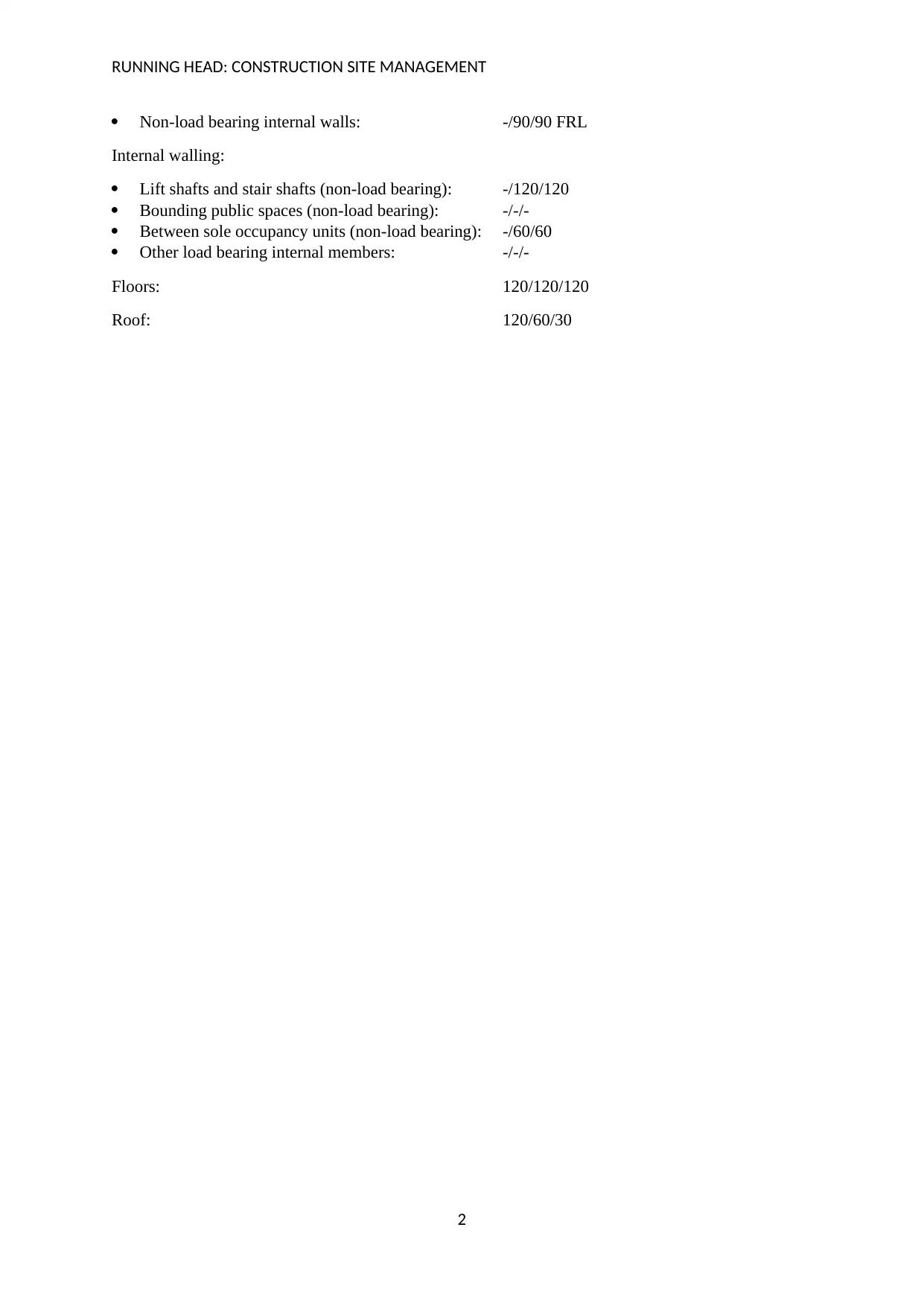
RUNNING HEAD: CONSTRUCTION SITE MANAGEMENT
Non-load bearing internal walls: -/90/90 FRL
Internal walling:
Lift shafts and stair shafts (non-load bearing): -/120/120
Bounding public spaces (non-load bearing): -/-/-
Between sole occupancy units (non-load bearing): -/60/60
Other load bearing internal members: -/-/-
Floors: 120/120/120
Roof: 120/60/30
2
Non-load bearing internal walls: -/90/90 FRL
Internal walling:
Lift shafts and stair shafts (non-load bearing): -/120/120
Bounding public spaces (non-load bearing): -/-/-
Between sole occupancy units (non-load bearing): -/60/60
Other load bearing internal members: -/-/-
Floors: 120/120/120
Roof: 120/60/30
2
⊘ This is a preview!⊘
Do you want full access?
Subscribe today to unlock all pages.

Trusted by 1+ million students worldwide
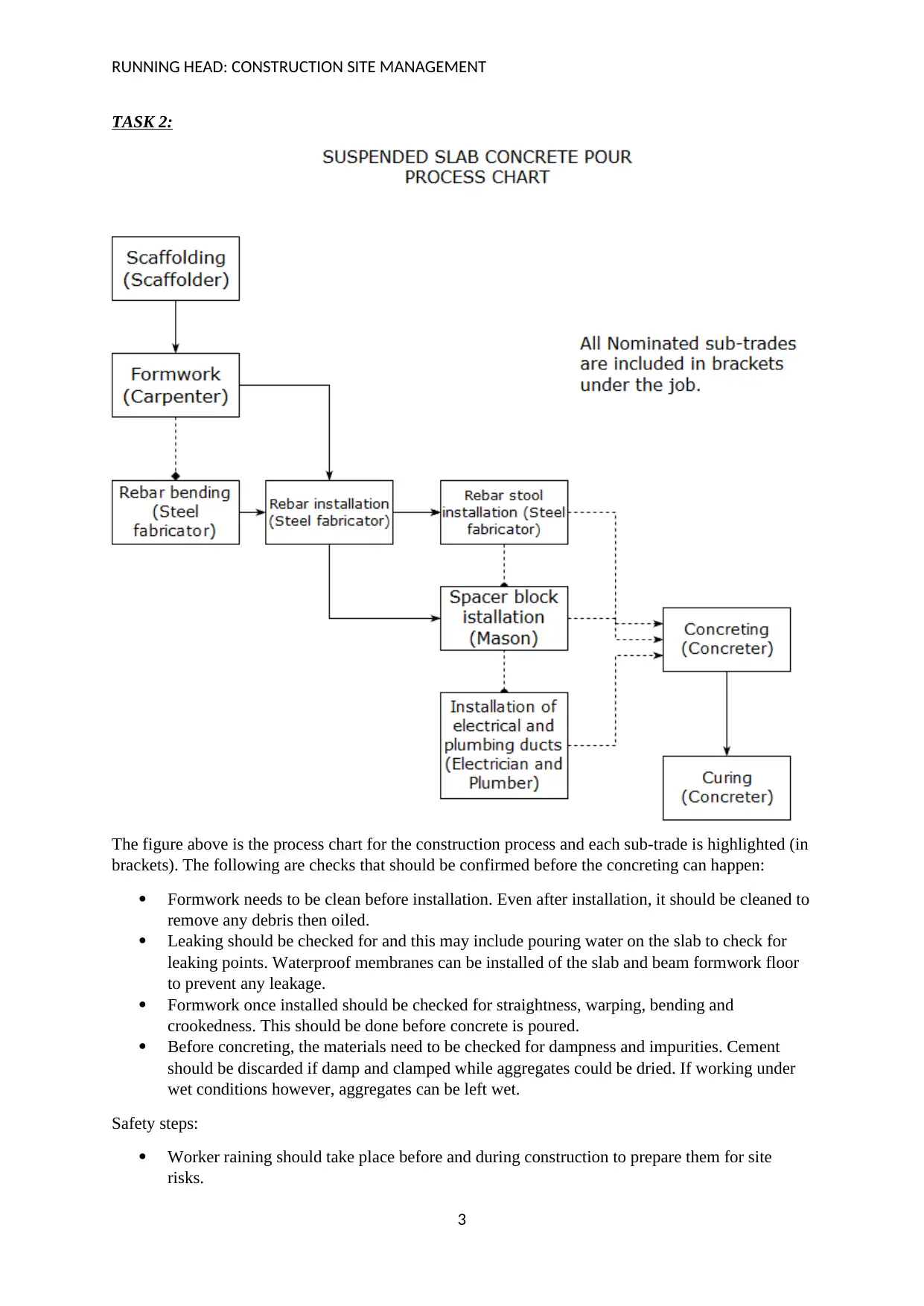
RUNNING HEAD: CONSTRUCTION SITE MANAGEMENT
TASK 2:
The figure above is the process chart for the construction process and each sub-trade is highlighted (in
brackets). The following are checks that should be confirmed before the concreting can happen:
Formwork needs to be clean before installation. Even after installation, it should be cleaned to
remove any debris then oiled.
Leaking should be checked for and this may include pouring water on the slab to check for
leaking points. Waterproof membranes can be installed of the slab and beam formwork floor
to prevent any leakage.
Formwork once installed should be checked for straightness, warping, bending and
crookedness. This should be done before concrete is poured.
Before concreting, the materials need to be checked for dampness and impurities. Cement
should be discarded if damp and clamped while aggregates could be dried. If working under
wet conditions however, aggregates can be left wet.
Safety steps:
Worker raining should take place before and during construction to prepare them for site
risks.
3
TASK 2:
The figure above is the process chart for the construction process and each sub-trade is highlighted (in
brackets). The following are checks that should be confirmed before the concreting can happen:
Formwork needs to be clean before installation. Even after installation, it should be cleaned to
remove any debris then oiled.
Leaking should be checked for and this may include pouring water on the slab to check for
leaking points. Waterproof membranes can be installed of the slab and beam formwork floor
to prevent any leakage.
Formwork once installed should be checked for straightness, warping, bending and
crookedness. This should be done before concrete is poured.
Before concreting, the materials need to be checked for dampness and impurities. Cement
should be discarded if damp and clamped while aggregates could be dried. If working under
wet conditions however, aggregates can be left wet.
Safety steps:
Worker raining should take place before and during construction to prepare them for site
risks.
3
Paraphrase This Document
Need a fresh take? Get an instant paraphrase of this document with our AI Paraphraser
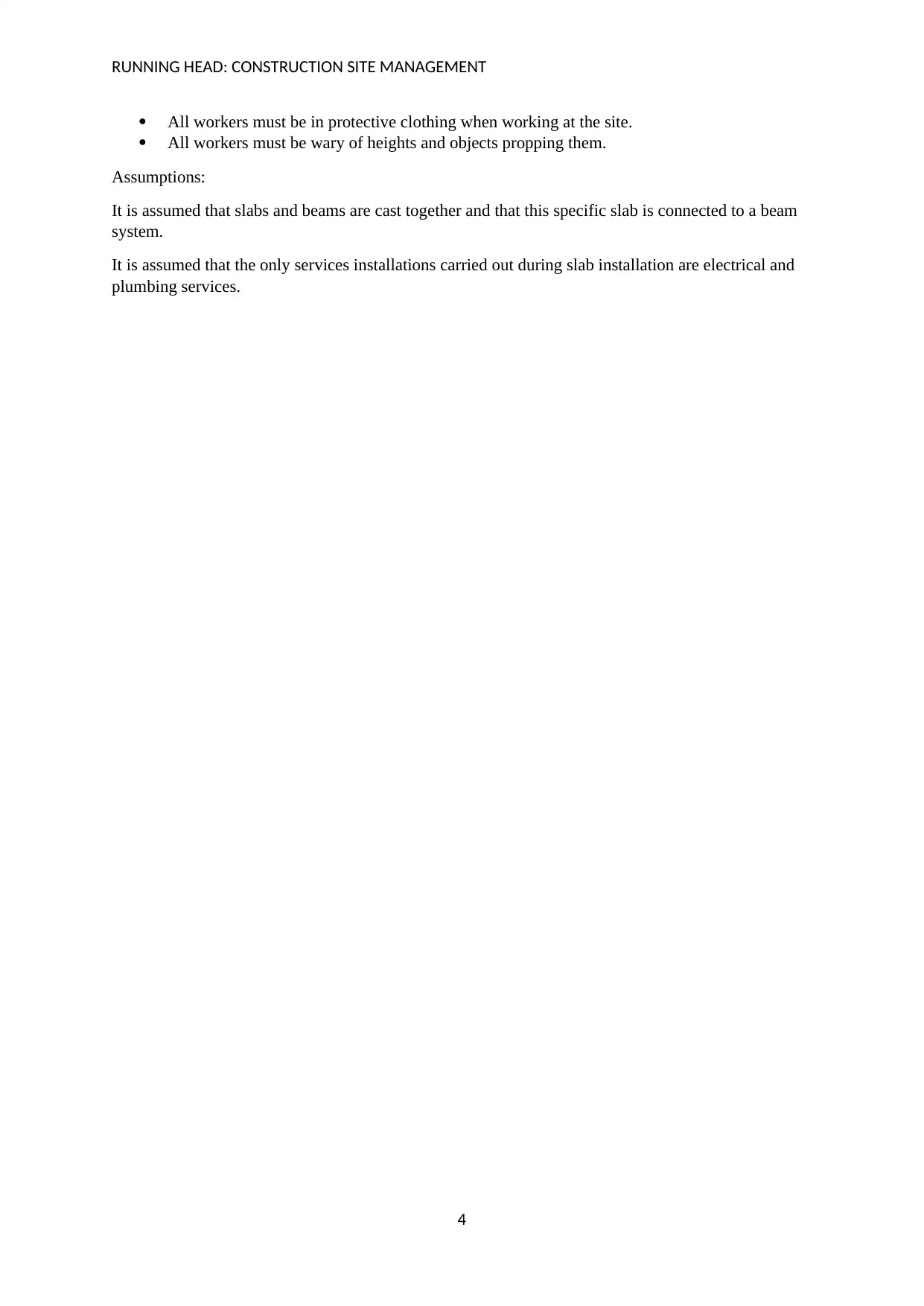
RUNNING HEAD: CONSTRUCTION SITE MANAGEMENT
All workers must be in protective clothing when working at the site.
All workers must be wary of heights and objects propping them.
Assumptions:
It is assumed that slabs and beams are cast together and that this specific slab is connected to a beam
system.
It is assumed that the only services installations carried out during slab installation are electrical and
plumbing services.
4
All workers must be in protective clothing when working at the site.
All workers must be wary of heights and objects propping them.
Assumptions:
It is assumed that slabs and beams are cast together and that this specific slab is connected to a beam
system.
It is assumed that the only services installations carried out during slab installation are electrical and
plumbing services.
4
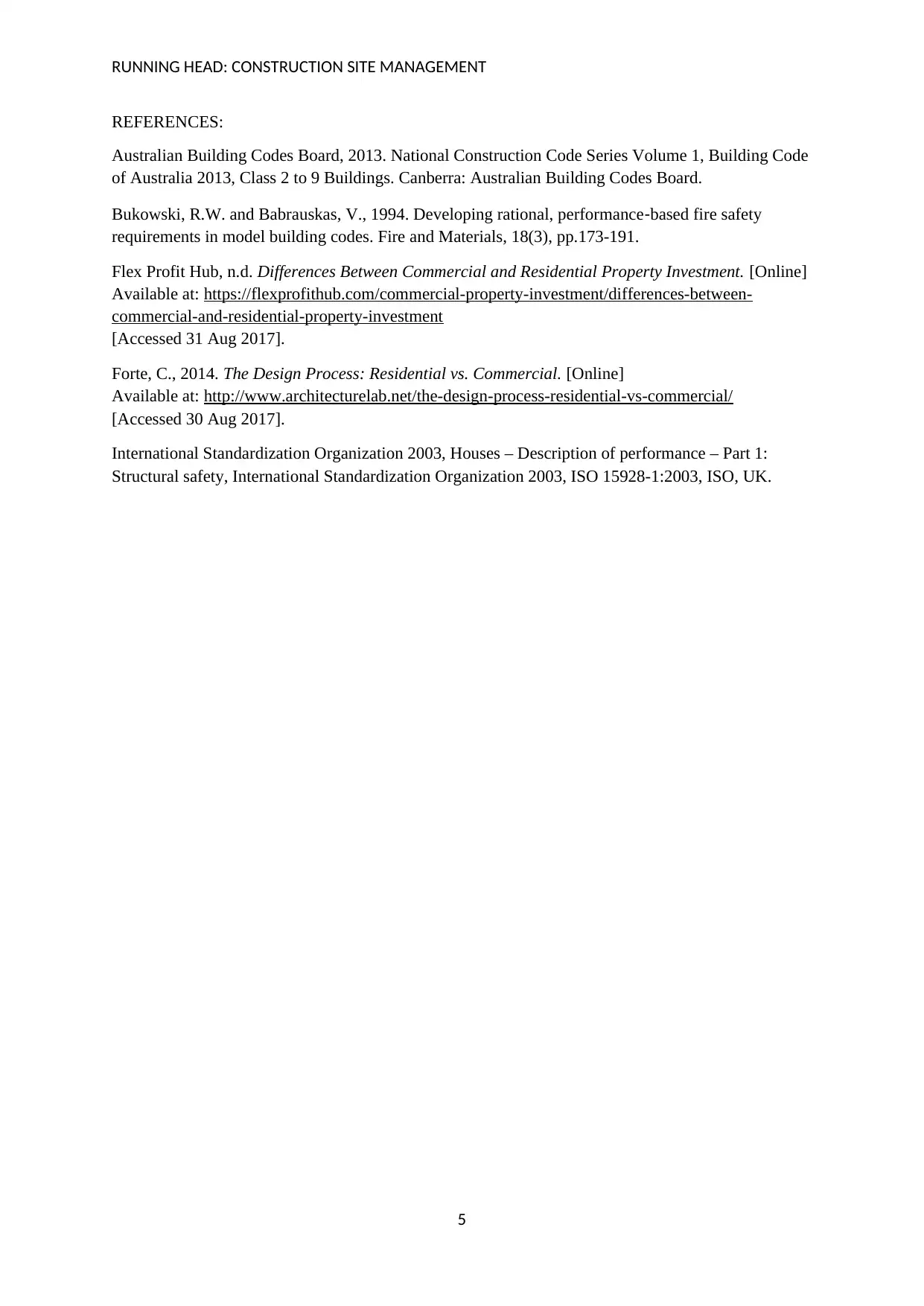
RUNNING HEAD: CONSTRUCTION SITE MANAGEMENT
REFERENCES:
Australian Building Codes Board, 2013. National Construction Code Series Volume 1, Building Code
of Australia 2013, Class 2 to 9 Buildings. Canberra: Australian Building Codes Board.
Bukowski, R.W. and Babrauskas, V., 1994. Developing rational, performance‐based fire safety
requirements in model building codes. Fire and Materials, 18(3), pp.173-191.
Flex Profit Hub, n.d. Differences Between Commercial and Residential Property Investment. [Online]
Available at: https://flexprofithub.com/commercial-property-investment/differences-between-
commercial-and-residential-property-investment
[Accessed 31 Aug 2017].
Forte, C., 2014. The Design Process: Residential vs. Commercial. [Online]
Available at: http://www.architecturelab.net/the-design-process-residential-vs-commercial/
[Accessed 30 Aug 2017].
International Standardization Organization 2003, Houses – Description of performance – Part 1:
Structural safety, International Standardization Organization 2003, ISO 15928-1:2003, ISO, UK.
5
REFERENCES:
Australian Building Codes Board, 2013. National Construction Code Series Volume 1, Building Code
of Australia 2013, Class 2 to 9 Buildings. Canberra: Australian Building Codes Board.
Bukowski, R.W. and Babrauskas, V., 1994. Developing rational, performance‐based fire safety
requirements in model building codes. Fire and Materials, 18(3), pp.173-191.
Flex Profit Hub, n.d. Differences Between Commercial and Residential Property Investment. [Online]
Available at: https://flexprofithub.com/commercial-property-investment/differences-between-
commercial-and-residential-property-investment
[Accessed 31 Aug 2017].
Forte, C., 2014. The Design Process: Residential vs. Commercial. [Online]
Available at: http://www.architecturelab.net/the-design-process-residential-vs-commercial/
[Accessed 30 Aug 2017].
International Standardization Organization 2003, Houses – Description of performance – Part 1:
Structural safety, International Standardization Organization 2003, ISO 15928-1:2003, ISO, UK.
5
⊘ This is a preview!⊘
Do you want full access?
Subscribe today to unlock all pages.

Trusted by 1+ million students worldwide
1 out of 6
Related Documents
Your All-in-One AI-Powered Toolkit for Academic Success.
+13062052269
info@desklib.com
Available 24*7 on WhatsApp / Email
![[object Object]](/_next/static/media/star-bottom.7253800d.svg)
Unlock your academic potential
Copyright © 2020–2025 A2Z Services. All Rights Reserved. Developed and managed by ZUCOL.





